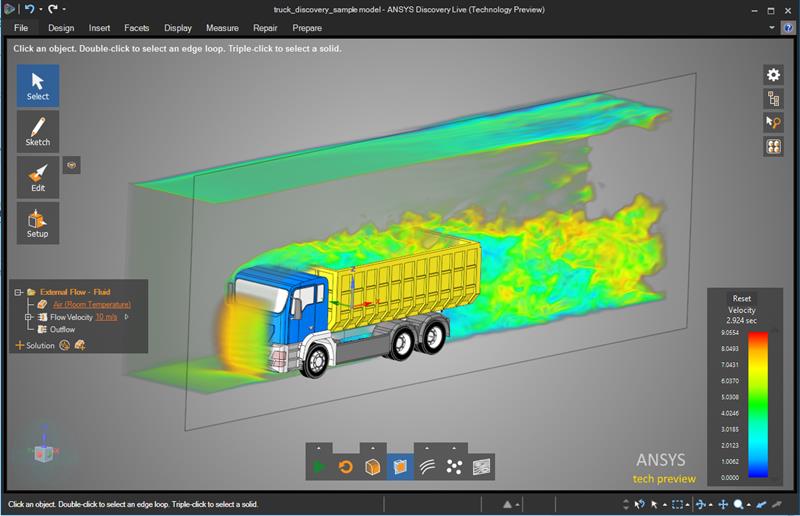Generative design is a form-finding process used by designers to optimise the strength-to-weight ratio of parts. It mimics the way natural structures evolve to create the strongest possible structure while minimising material use.
For example, human bone has intricate internal and external features; the hard outer (Cortical) bone forms a rigid outer layer, but also allows blood vessels to pass through it into the honeycomb-like matrix on the inside. This honeycombing is made from collagen fibres and gives the bone incredible tensile and compressive strength.
As such, honeycomb structures have been incorporated in parts from aeroplane turbine blades to the humble cardboard box. In all these applications, the honeycomb makes the parts stronger and lighter. This is especially important when they are being transported – or being used to transport people and cargo – because less fuel is used to do so.
In the quest to make ever stronger parts while minimising waste and reducing material cost, generative design has become an invaluable tool. Using this software, designers can iterate hundreds, or even thousands of different designs without having to create a single physical prototype. This plethora of designs is created by inputting different parameters such as varying levels of stress, temperature or humidity to which the part could be subject in its working environment.
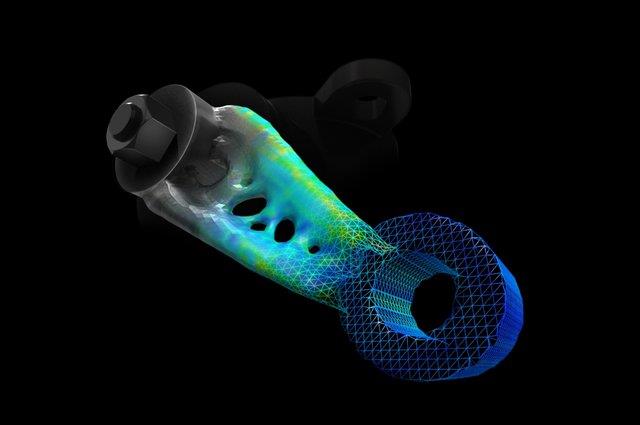 The drawback of this is that the parameters must be input manually. But now, one manufacturer is looking to change that so that organic generative design can be carried out in true real time, including changes in parameters. The company also wants to provide this for 3D printed metal components.
The drawback of this is that the parameters must be input manually. But now, one manufacturer is looking to change that so that organic generative design can be carried out in true real time, including changes in parameters. The company also wants to provide this for 3D printed metal components.
Desktop Metal has been exploring a solution to simplify generative design for 3D printing. The result of this research is ‘Live Parts’, an experimental technology that applies morphogenetic principles (i.e. the mimicking of organic cell behaviour) and advanced simulation to auto-generate part designs in minutes.
Jonah Myerberg, chief technical officer of Desktop Metal says: “That’s where generative design is going to come in and be a very important process. This is why Desktop Metal is creating tools like Live Parts – to help engineers be more efficient.”
Live Parts goes beyond the ‘standard’ generative design software, however. Where traditional software mimics biology and uses natural-looking features in its designs, Live Parts recreates the cellular mechanisms that create natural structures like plants and animals to generate parts automatically.
Andy Roberts, senior software engineer and inventor of Live Parts, explains: “In nature, nobody sketches a tree and then puts it in place. Instead, everything grows from cells. You start with a single cell, you grow it into an embryo, the embryo grows into an organism and as it’s growing, it’s adapting to its environment in real time.”
If this all seems a bit abstract, what it really means is that, rather than set an envelope constraint in which you want your part to be built, you simply mark out the areas where you want to plant your ‘seed cells’ (from which the part will grow), ‘attractor zones’ (where the cells should grow to) and ‘keep out zones’ (which should be left clear for the part to be attached to another component).
Roberts continues: “The seed cells grow towards their target in the same way that plants grow towards the light. What this part is doing is effectively growing to support the loads that are being applied.”
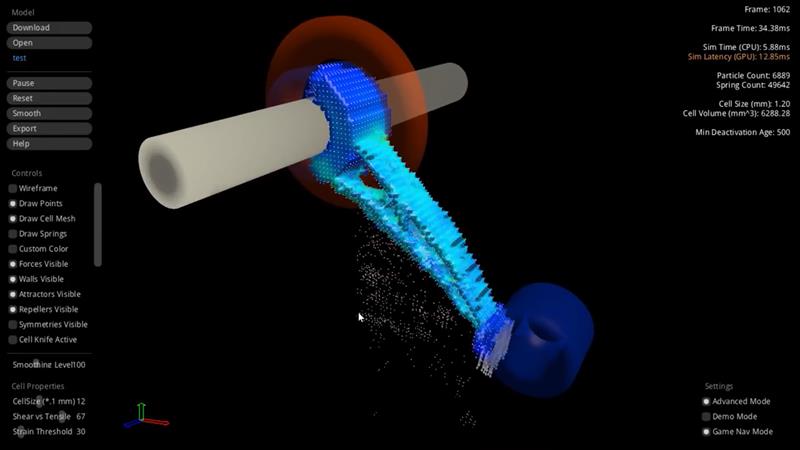
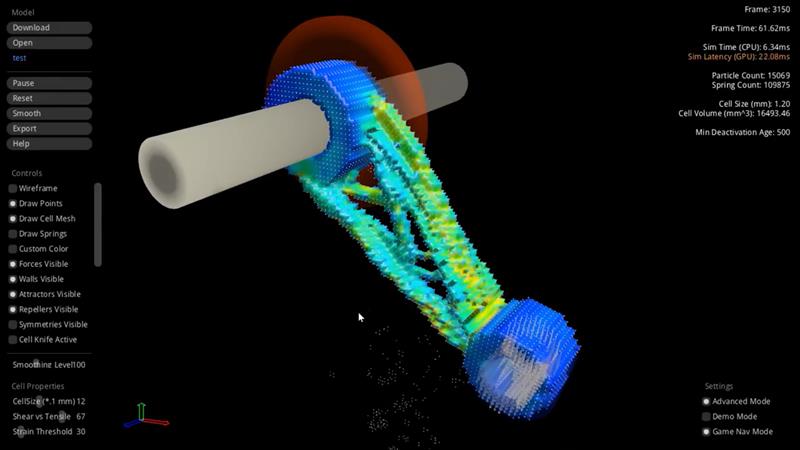
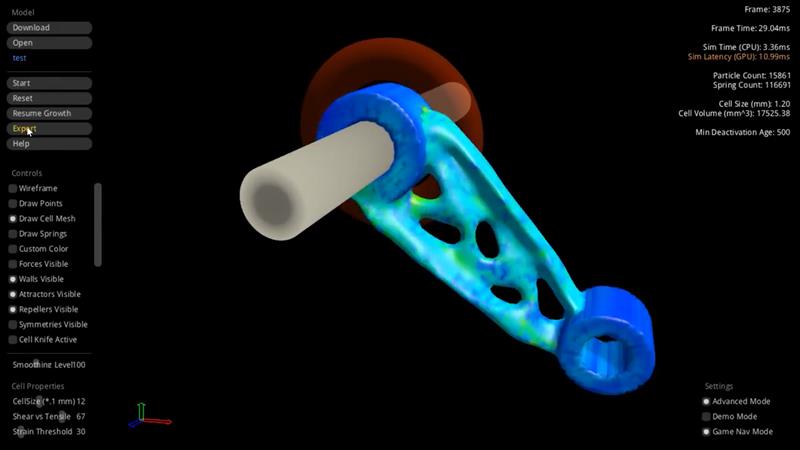
Seed cells grow towards and around the attractor zones, multiplying in areas that are under stress and falling off from where they are not
In response to load placed upon the part, the cells communicate in a similar way as natural cells, they divide and produce ‘child cells’ which thicken and strengthen the part in the areas where load is causing the most stress, spreading it evenly over the surface of the part. At the same time, in areas where there is no stress being exerted, cells are not needed and so they are literally ejected and fall off the part towards the bottom of the screen.
Another important aspect of the software is the ability to apply multiple forces to the part, which, thanks to some complex algorithms, reacts in real time, producing flanges and other support structures to compensate.
“What would happen is, we’d define the load in a certain direction and the part would grow perfectly for that case,” says Roberts. “But then there’d be this little tweak or anomaly and the whole thing would crash and fall down.
“That’s because we hadn’t anticipated all the different load cases, so we’ve built in background gravity waves that constantly oscillate in a way that creates forces that are unanticipated on the organism. We call these transitional forces and this gives us the ability to create parts that can handle not only the forces that you define but also forces that may be unexpected.
“You don’t want to create parts where if you accidentally drop them on the floor they shatter because that was not an anticipated case.”
Live Parts is able to react so quickly because it runs in the cloud and via a 3000 core GPU, the kind that is used in autonomous vehicles.
Desktop Metal has struck a deal with SolidWorks that sees Live Parts integrated as a feature-based add-in to its software. This means design engineers can set where the seed cells are planted and where the attractor and keep-out zones are to be placed, and upload this to the cloud. Here, Live Parts will grow the part, the designer then smooths it off and exports it back into SolidWorks where features can be added or cut out. Finite element analysis and mechanical analysis can also be carried out to put the part through its paces.
Myerberg adds: “This is the foundation of a new tool. It’s a new environment in which engineers can create extremely complicated geometry and we are very excited to be working with SolidWorks and making this new tool available early to the SolidWorks community.”
Live Parts is still in active development so, as users explore it, Desktop Metal is looking for feedback to make it more effective. For example, one of the next big features currently in development is the ability to add material properties so engineers can really tune in the factors of safety that are needed to use these parts in real-life applications.
Real-time simulation Another company looking to bring instant feedback to design engineers is multi-physics software developer ANSYS. Its Discovery Live platform allows changes to be made to a CAD model to show how fluid or air flow is affected in real time and can be used by anyone, not just specialists. Instead of taking days, months or weeks to set up, run and analyse digital prototypes with traditional engineering simulation solutions, Discovery Live allows engineers to examine the impact of their design changes immediately. Users can pose hypotheticals upfront in the design process to explore thousands of design options rapidly and receive immediate feedback – enabling the user to explore the impact of changes digitally while results update immediately. For the first time, engineers can rapidly explore design options and receive instant and accurate simulation results with cutting-edge technology that can be run on most standard laptops. “We’ve rewritten, from the ground up, the classic simulation algorithms to run natively on the GPU architecture, and that’s what gives you the speed,” says Mark Hindsbo, vice president and general manager at ANSYS. “And it’s not some insane graphics card, it’s a modern 4GB NVidia graphic card with a number of CUDA cores to run on.” Discovery Live supports fluids, structural and thermal simulation applications. Users can run an analysis-first approach as they design – enabling them to iterate with a 3D model and interactively explore the impact of simple and complex changes. |
Biological structures at SolidWorks World Going even further in the realm of bio-inspired design, MIT’s Professor Neri Oxman gave an insight into future sustainable construction at SolidWorks World 2018. Her group, Mediated Matter, is working on a different kind of seed cells, ones made of biological materials that can be programmed to form micro-colonies 150 microns in diameter. “We are moving from the age of the machine to the age of the organism, from the assembly age to the biological age, or the bio-digital age as I like to call it,” Prof Oxman says. According to Prof Oxman, when these programmed colonies are uploaded to the genome of a synthetically engineered micro-organism, that micro-organism can evolve over time to generate a synthetic tree or, with enough control, an organic skyscraper. To prove the technology, Mediated Matter is installing a 6 metre pavilion in the lobby of MIT’s Media Lab that is made entirely out of biological materials, making it the world’s first bio-compatible building. |


